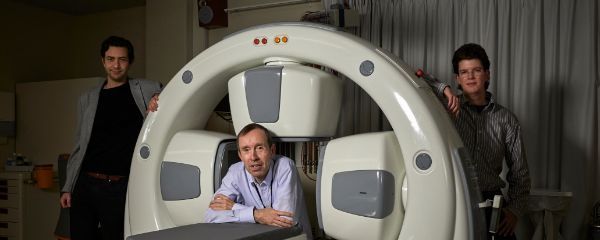Hyperboost study
Hans Crezee, a physicist and principal investigator in the Radiotherapy Department of Amsterdam UMC, has been researching and developing the necessary equipment for hyperthermia treatment for many years. He has organized a collaboration with eleven hospitals, technical universities and companies in Europe to further scientifically substantiate and thus boost effectiveness of hyperthermia cancer therapy.
Last year, the consortium received an Innovative Training Network (ITN) grant funded by the European Union Marie Skłodowska-Curie Action program of 3.7 million euro for this ‘Hyperboost’ study, in which fourteen PhD students are trained. This includes a clinical study, initially focusing on boosting the combination of hyperthermia and radiotherapy at five hospitals in Switzerland, Germany and the Netherlands.
We unite groups that conduct fundamental research with groups that apply hyperthermia in the clinic - Hans Crezee
Heat shock
When the temperature in a specific area of the body is raised a few degrees, proteins in the tumor cells become severely affected, and membranes and blood vessels soften and become more porous. As a result, tumor cells may die directly, or more chemotherapy can enter the tumor tissue. Importantly, local heating boosts blood circulation as the body tries to counteract the increase in local temperature. Oxygen levels are usually low in tumors, making cancerous cells less sensitive to chemo and radiation treatment. However, the extra local blood supply caused by hyperthermia therapy increases the amount of oxygen and the sensitivity of cancer cells to chemo or radiation. Hyperthermia also boosts effectivity by preventing repair of damaged tumor DNA following chemo- or radiotherapy. Furthermore, the immune system is activated by a surge of so-called heat shock proteins in the tumor tissues, with even some evidence that subsequently metastases are tackled as well.
Hyperboost research will first focus on evaluating the specific contributions of these effects to boost the effectivity of hyperthermia combined with radiotherapy. The molecular biologist Przemek Krawczyk is leading the fundamental research of Hyperboost at Cancer Center Amsterdam.
Patient-specific treatment
Dr. Crezee emphasizes that an important aim of Hyperboost is to make hyperthermia part of patient-specific treatment. When standard treatment is insufficient, heat treatment may offer benefit as an additional tool. Lead principal investigator Petra Kok, computational scientist in the Radiotherapy department, explains that separate treatment planning schedules already exist for radiotherapy and hyperthermia. The challenge is to combine these into one integrated treatment planning program. “Combining the two is challenging,” says Kok, “because we are dealing with so many different mechanisms by which hyperthermia impacts the tumor environment. In addition, it is important to consider when and how often hyperthermia should be combined with radiotherapy, for optimum efficacy. This also depends on the tumor type, size, properties and location. Ultimately, one tries to compute the optimal combined radiotherapy and hyperthermia planning for each patient with as few side effects as possible. Once that succeeds, we will also include chemotherapy in the model.”
The project participants anticipate that the knowledge and tools gained during the Hyperboost project will open the door to more wide-spread use of hyperthermia in clinical cancer centers in support of advancing personalized medicine and improving therapies for cancer patients in the future.
 Photo: Mark Horn
Photo: Mark Horn
Photo: Mark Horn
This article has been adapted from popular scientific magazine JANUS
For more information, see the project website

